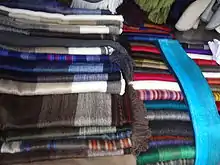Scarf
A scarf, plural scarves, is a piece of fabric worn around the neck or head for warmth, sun protection, cleanliness, fashion, or religious reasons or used to show the support for a sports club or team. They can be made in a variety of different materials such as wool, linen, silk or cotton. It is a common type of neckwear.


History
Scarves have been worn since ancient times.[1] The Statue of Ashurnasirpal II from the 9th century BC features the emperor wearing a shawl. In Ancient Rome, the garment was used to keep clean rather than warm. It was called a focale or sudarium (sudarium from the Latin for "sweat cloth"), and was used to wipe the sweat from the neck and face in hot weather. They were originally worn by men around their neck or tied to their belt.
Historians believe that during the reign of the Chinese Emperor Cheng, scarves made of cloth were used to identify officers or the rank of Chinese warriors.
In later times, scarves were also worn by soldiers of all ranks in Croatia around the 17th century. The only difference in the soldiers' scarves that designated a difference in rank was that the officers had silk scarves whilst the other ranks were issued with cotton scarves. Some of the Croatian soldiers served as mercenaries with the French forces. The men's scarves were sometimes referred to as "cravats" (from the French cravate, meaning "Croat"), and were the precursor of the necktie.
The scarf became a real fashion accessory by the early 19th century for both men and women. By the middle of the 20th century, scarves became one of the most essential and versatile clothing accessories for both men and women.
Uses and types
In cold climates, a thick knitted scarf, often made of wool, is tied around the neck to keep warm. This is usually accompanied by a heavy jacket or coat. Also, the scarf could be used to wrap around the face and ears for additional cover from the cold.
In drier, dustier warm climates, or in environments where there are many airborne contaminants, a thin headscarf, kerchief, or bandanna is often worn over the eyes and nose and mouth to keep the hair clean. Over time, this custom has evolved into a fashionable item in many cultures, particularly among women. The cravat, an ancestor of the necktie and bow tie, evolved from scarves of this sort in Croatia.[2]
In India, woollen scarfs with Bandhani work use tie and dye technique used commonly in Bhuj and Mandvi of the Kutch District of Gujarat State.
Scarves that are used to cover the lower part of face are sometimes called a cowl. Scarves can be colloquially called a neck-wrap.
Scarfs can be tied in many ways including the pussy-cat bow, the square knot, the cowboy bib, the ascot knot, the loop, the necktie, and the gypsy kerchief.[3] Scarfs can also be tied in various ways on the head.
In religious or cultural use
Several Christian denominations include a scarf known as a Stole as part of their liturgical vestments.
In uniforms
Silk scarves were used by pilots of early aircraft in order to keep oily smoke from the exhaust out of their mouths while flying. These were worn by pilots of closed cockpit aircraft to prevent neck chafing, especially by fighter pilots, who were constantly turning their heads from side to side watching for enemy aircraft. Today, military flight crews wear scarves imprinted with unit insignia and emblems not for functional reasons but instead for esprit-de-corps and heritage.
Students in the United Kingdom traditionally wear academic scarves with distinctive combinations of striped colours identifying their individual university or college.
Members of the Scouting movement wear a scarf-like item called a neckerchief as part of their uniform, which is sometimes referred to as a scarf. In some Socialist countries Young pioneers wore a neckerchief called a red scarf.
In sport


Since at least the early 1900s, when the phenomenon began in Britain, coloured scarves have been traditional supporter wear for fans of association football teams across the world, even those in warmer climates. These scarves come in a wide variety of sizes and are made in a club's particular colours and may contain the club crest, pictures of renowned players, and various slogans relating to the history of the club and its rivalry with others. At some clubs supporters will sometimes perform a 'scarf wall' in which all supporters in a section of the stadium will stretch out their scarves above their heads with both hands, creating an impressive 'wall' of colour.
This is usually accompanied by the singing of a club anthem such as "You'll Never Walk Alone" at Liverpool F.C.[4] or "Grazie Roma" at A.S. Roma. This was initially solely a British phenomenon, but has since spread to the rest of Europe, North and South America. Some clubs supporters will perform a scarf 'twirl' or 'twirly' in which a group of supporters hold the scarves above their heads with one hand, and twirl the scarf, creating a 'blizzard' of colour. This is usually accompanied by a club anthem such as "Hey Jude" at Heart of Midlothian F.C.
Scarf wearing is also a noted feature of support for Australian rules football clubs in the Australian Football League. The scarves are in the form of alternating bars of colour, usually with the team name or mascot written on each second bar.
Gallery
_1892.jpg.webp) Aristide Bruant and scarf by Henri de Toulouse-Lautrec
Aristide Bruant and scarf by Henri de Toulouse-Lautrec Woman wearing a 1920s head and neck scarf.
Woman wearing a 1920s head and neck scarf.
 Baby in heavy winter clothing including a woollen scarf.
Baby in heavy winter clothing including a woollen scarf.
Manufacturing of scarves
The craft of knitting garments such as scarves is an important trade in some countries. Hand-knitted scarves are still common as gifts as well.
Printed scarves are additionally offered internationally through high fashion design houses. Among the latter are Burberry, Missoni, Alexander McQueen, Cole Haan, Chanel, Etro, Lanvin, Hermès, Nicole Miller, Ferragamo, Emilio Pucci, Dior, Fendi, Louis Vuitton and Prada.
There are three basic scarf shapes: square, triangular and rectangular.[3]
The main manufacturer of fashion scarves used today is China; India, Hong Kong and Indonesia close behind. The most common materials used to make fashion scarves are silk, fleece, cotton, Rayon, Viscose, modal and pashmina or other cashmere wool. This scarf standard size are size 50*180 cm, 70*180 cm, 100*180 cm Square -100*100 cm 90*90 cm this are comanly used in all over the world
References
- Mackrell, Alice (1986). Shawls, stoles, and scarves. London: Batsford. ISBN 0713448768.
- "Necktie." World of Invention, Gale, 2006. Biography In Context, http://link.galegroup.com/apps/doc/CV1647500543/BIC?u=lom_waynesu&sid=BIC&xid=a9ae2de6. Accessed 1 Feb. 2019.
- Perry, Patricia, (1971). "Everything About Sewing Ponchos Capes Scarves & Stoles", New York: Butterick Fashion Marketing Company. 70-169062
- "'You'll Never Walk Alone': The Power of a Song". FIFA. 21 December 2016. Retrieved 15 March 2018.